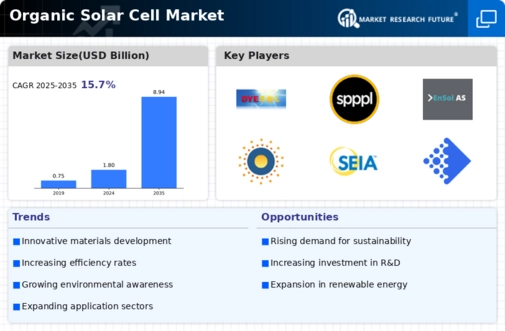Market Growth Projections
Growing Demand for Renewable Energy
The Global Organic Solar Cell Market Industry is witnessing an increasing demand for renewable energy sources, driven by global initiatives to reduce carbon emissions and combat climate change. Governments worldwide are implementing policies that promote the adoption of clean energy technologies, which is likely to bolster the market for organic solar cells. In 2024, the market is projected to reach 1.8 USD Billion, reflecting a growing recognition of the need for sustainable energy solutions. This trend suggests that organic solar cells, with their potential for lower production costs and flexibility, may play a crucial role in meeting future energy demands.
Environmental Benefits and Sustainability
The environmental advantages of organic solar cells are becoming increasingly recognized, which may drive growth in the Global Organic Solar Cell Market Industry. Organic solar cells are often produced using less energy-intensive processes compared to conventional solar technologies, resulting in a lower carbon footprint. This sustainability aspect appeals to environmentally conscious consumers and businesses, potentially increasing demand. As awareness of environmental issues continues to rise, organic solar cells may emerge as a preferred choice for renewable energy solutions. The market's growth trajectory suggests that these benefits will play a pivotal role in shaping consumer preferences and driving adoption.
Increasing Investment in Solar Technology
Investment in solar technology is on the rise, which is likely to have a positive impact on the Global Organic Solar Cell Market Industry. Governments and private entities are channeling funds into research and development initiatives aimed at enhancing solar energy technologies. This influx of capital is expected to accelerate the commercialization of organic solar cells, making them more accessible to consumers and businesses alike. The anticipated compound annual growth rate of 15.69% from 2025 to 2035 indicates a robust market trajectory, driven by these investments. As organic solar cells become more mainstream, their adoption could significantly contribute to global energy sustainability.
Diverse Applications of Organic Solar Cells
The versatility of organic solar cells is contributing to their appeal in the Global Organic Solar Cell Market Industry. These cells can be integrated into various applications, including building-integrated photovoltaics, portable electronics, and even wearable technology. This adaptability allows for innovative uses that traditional solar technologies may not accommodate. As the market evolves, the potential for organic solar cells to penetrate diverse sectors could lead to increased adoption rates. The ongoing exploration of new applications may further enhance the market's growth, as industries seek to leverage the unique properties of organic solar cells for energy generation.
Technological Advancements in Organic Solar Cells
Technological innovations are significantly enhancing the efficiency and viability of organic solar cells, thereby propelling the Global Organic Solar Cell Market Industry. Recent advancements in materials science, such as the development of novel organic semiconductors, have led to improved energy conversion efficiencies. These innovations are expected to make organic solar cells more competitive with traditional photovoltaic technologies. As a result, the market is anticipated to grow substantially, with projections indicating a rise to 8.94 USD Billion by 2035. This growth may be further supported by ongoing research and development efforts aimed at optimizing the performance and durability of organic solar cells.










